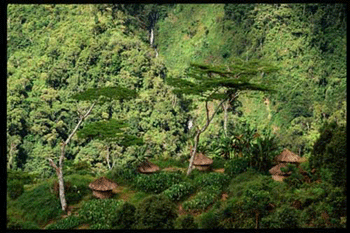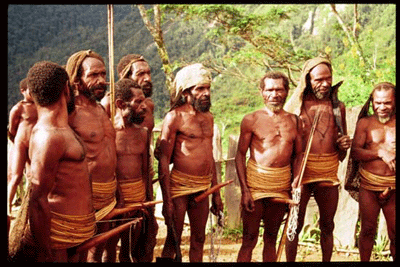Irian Jaya’s Kombai
The Tree House People
 After our trek to the Kombai, we flew to the mountain tribe of the Yali. The mountains of Irian Jaya reach heights of up to sixteen thousand feet. Our small bush plane was incapable of flying over many of them so our pilot was forced to wind his way through canyons and over mountain passes. After awhile, we began to see villages perched on steep ridges and were told that we were now in Yali territory. Our pilot landed on a very small dirt runway that was carved out of the top of a ridge with sheer drops on two sides. A group of Yali were gathered around watching us come in.
After our trek to the Kombai, we flew to the mountain tribe of the Yali. The mountains of Irian Jaya reach heights of up to sixteen thousand feet. Our small bush plane was incapable of flying over many of them so our pilot was forced to wind his way through canyons and over mountain passes. After awhile, we began to see villages perched on steep ridges and were told that we were now in Yali territory. Our pilot landed on a very small dirt runway that was carved out of the top of a ridge with sheer drops on two sides. A group of Yali were gathered around watching us come in.
 The Yali have had more contact with the outside world than the Kombai. We were told the Yali normally receive about 200 visitors a year. The arrival of a plane is still an exciting event for them, however, as they can get news from the outside world and receive supplies from the regional center of Wamena. We were told that there had been virtually no visitors the year before, as there had a been a kidnapping which had frightened away most people.
The Yali have had more contact with the outside world than the Kombai. We were told the Yali normally receive about 200 visitors a year. The arrival of a plane is still an exciting event for them, however, as they can get news from the outside world and receive supplies from the regional center of Wamena. We were told that there had been virtually no visitors the year before, as there had a been a kidnapping which had frightened away most people.
Even though the Yali have had a lot of contact with missionaries, they still stick to many of their traditional ways. The men wear long penis gourds and hoops made of rattan. Each hoop is place individually around the mens waist and no two hoops are connected. I couldn’t tell exactly how the men managed to keep the hoops from dropping down to the ground. They seemed to be held up only by the penis gourd and the mens bow legged gait.
 Unlike the Kombai, the Yali are not shy. They crowded around us and followed us where ever we went. They did not like to have their photographs taken, however, and this explains how I got this shot of the village without anyone getting in the way. Other than when we had the cameras out, we were surrounded by people from the moment we woke to the moment we went to bed.
Unlike the Kombai, the Yali are not shy. They crowded around us and followed us where ever we went. They did not like to have their photographs taken, however, and this explains how I got this shot of the village without anyone getting in the way. Other than when we had the cameras out, we were surrounded by people from the moment we woke to the moment we went to bed.
We hired some porters the next day and started our hike. For several days we hiked over very steep, wet, and slippery terrain. Yali trails do not have switch backs so we spent our days hiking straight up and straight down ridge after ridge. We slept in villages along the way which all seemed to be perched on top of the knife edged ridges. The Yali, like the Kombai, traditionally lived in a state of constant warfare with all their neighbors and thus needed the protection of the high ground to defend themselves. Even though the government of Indonesia discourages inter-clan and inter-tribal warfare, the Yali still feel more secure on the ridge tops. The villages were very picturesque and had great views, but always took a great deal of effort to reach.
On the second day of our trek, one of our porters broke out in rashes all over his body and couldn’t stop scratching himself. The other porters collected medicinal leaves from the nearby slopes and he rubbed them all over his body. We gave him some anti itch cream and told him that he should go back to the airstrip town where there was a nurse. He insisted over and over again that he wasn’t sick, but that someone from the village the night before had put a curse on him. He refused to go turn back and continued on with us. Happily, the next day he was fine.
 After hiking up a particularly steep canyon wall, I saw that we were nearing a village. My porter and I had gotten quite a bit ahead of the rest of group and I wanted to wait, but he kept urging me on and it was easier to follow him then try to communicate my wishes to him. After another twenty minutes I reached the top of the ridge, and while breathing heavily and sweating profusely, I was surrounded by a group of about a hundred Yali. I smiled and nodded at them, but they all just stood there looking at me with serious and unsmiling faces. I didn’t know what to do so I just stood there hoping that the rest of my group would hurry up and arrive. I was tired from the climb and wanted to sit down, but it seemed like it would be awkward to do so with that large and seemingly unfriendly crowd starring down at me. Finally about half of them broke away and ran to the canyon edge and looked down. I also went over and was happy to see my group approaching. My guide was able to negotiate an agreement with them for us to spend the night there. Although we were welcomed to the village, I never felt completely at ease there. The women and children of the village always seemed a little fightened of us. Numerous times the children would run from us as we approached.
After hiking up a particularly steep canyon wall, I saw that we were nearing a village. My porter and I had gotten quite a bit ahead of the rest of group and I wanted to wait, but he kept urging me on and it was easier to follow him then try to communicate my wishes to him. After another twenty minutes I reached the top of the ridge, and while breathing heavily and sweating profusely, I was surrounded by a group of about a hundred Yali. I smiled and nodded at them, but they all just stood there looking at me with serious and unsmiling faces. I didn’t know what to do so I just stood there hoping that the rest of my group would hurry up and arrive. I was tired from the climb and wanted to sit down, but it seemed like it would be awkward to do so with that large and seemingly unfriendly crowd starring down at me. Finally about half of them broke away and ran to the canyon edge and looked down. I also went over and was happy to see my group approaching. My guide was able to negotiate an agreement with them for us to spend the night there. Although we were welcomed to the village, I never felt completely at ease there. The women and children of the village always seemed a little fightened of us. Numerous times the children would run from us as we approached.
 The next day we paid for a pig feast. The pig was shot with a single arrow and died disturbingly quickly for such a small wound. The archer knew just where to hit it. It was cut up and wrapped in leaves and buried with hot rocks. As we had paid for the feast, the villagers were more tolerant of picture taking them usual, but even so the women tended to look away when we pointed our cameras in their direction.
The next day we paid for a pig feast. The pig was shot with a single arrow and died disturbingly quickly for such a small wound. The archer knew just where to hit it. It was cut up and wrapped in leaves and buried with hot rocks. As we had paid for the feast, the villagers were more tolerant of picture taking them usual, but even so the women tended to look away when we pointed our cameras in their direction.
Our guide told us that he had been talking to the villagers and learned that inhabitants of this village used to belong to two other villages situated in the valley below. In the 1970s both villages were wiped out by a surprise attack from a neighboring clan. The survivors joined together and founded this village on the ridge.
Later, we spent a very long day scrambling up and down mountain ridges hurrying to reach the airstrip in time for our rendezvous with the plane. We made it back to the village just as a tropical down pour was starting. The next day it was still raining and we were told that the plane would not come and get us. We needed food so we bought the local rooster thinking that if we ate it it wouldn’t be waking us up again the next morning with its crowing. After dinner it was still raining, and some of the villagers performed some “black magic” to make it stop for us. They collected some rain water in an old tin can, put some dirt in it, and set the can on a fire for the water to boil away. I’m very skeptical that it did any good, but the next morning it was clear and the plane came and got us.


